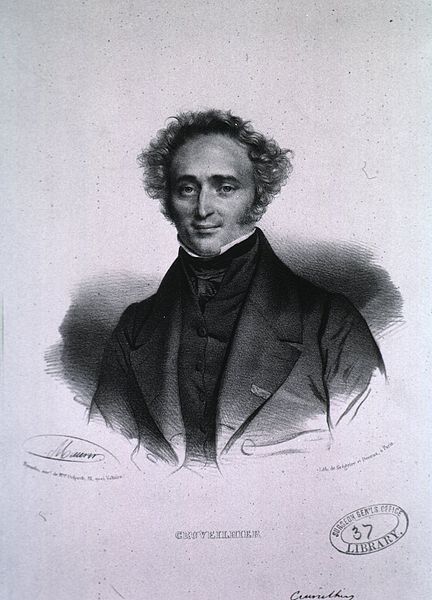<Back to Index>
- Anatomist and Pathologist Jean Cruveilhier, 1791
PAGE SPONSOR

Jean Cruveilhier (February 9, 1791 in Limoges, France – March 7, 1874 in Sussac) was a French anatomist and pathologist.
In 1816 he earned his doctorate in Paris, where in 1825 he succeeded Pierre Augustin Béclard (1785 – 1825) as professor of anatomy. In 1836 he relinquished the chair of anatomy to Gilbert Breschet (1784 – 1845), and became the first occupant of the recently founded chair of pathological anatomy. In 1836 he was elected to the Académie de Médecine, becoming its president in 1839. For over forty years he was president of the Société anatomique. Puerto Rican pro-independence leader, surgeon and Légion d'honneur laureate, Ramón Emeterio Betances, was one of his prominent students.
Cruveilhier was a highly influential anatomist, and made important contributions in his studies involving the nervous system. He described the pathology of neuronal lesions observed in what today is known as multiple sclerosis, publishing his findings and illustrations in 1842. He was also the first to record the clinical history of a patient who had the disease. However, it wasn't until 1868 that multiple sclerosis was discovered by neurologist Jean - Martin Charcot to be a distinct, separate disease.
He also performed extensive studies on inflammation of blood vessels, particularly phlebitis, which he believed was the overall cause of most inflammations. Cruveilhier was a prolific writer, among his works were Anatomie pathologique du corps humain (1829 – 1842) and Vie de Dupuytren (Life of Dupuytren, 1840), which was a memorial to his teacher, Guillaume Dupuytren.
His name is associated with Cruveilhier's sign (persistent hypertension and occlusion of the portal vein) and Cruveilhier - Baumgarten disease (cirrhosis of the liver without ascites), which is named along with anatomist Paul Clemens von Baumgarten. Cruveilhier's name is also associated with several parts of the anatomy, however these terms have largely been replaced by the modern anatomical nomenclature:
- Cruveilhier's fossa: scaphoid fossa
- Cruveilhier's fascia: superficial fascia of perineum
- Cruveilhier's joint: median atlanto - axial joint
- Cruveilhier's plexus: posterior cervical plexus